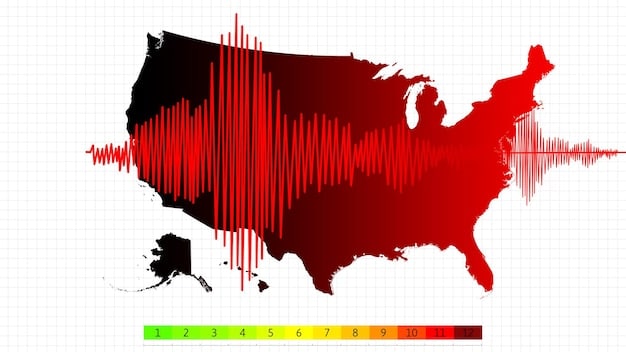Big Data’s Role in US Social Issues: 2025 Analysis

Looking ahead to 2025, understanding how big data is actively shaping and addressing complex social challenges across the United States is crucial for policy makers and citizens alike, offering unprecedented insights and new avenues for intervention.
The landscape of social challenges in the United States is vast and complex, ranging from public health crises to economic disparities and environmental concerns. As we approach 2025, a powerful tool is increasingly at our disposal: big data. Understanding The Role of Big Data in Addressing Social Issues in the US: A 2025 Analysis involves delving into how massive datasets, sophisticated analytics, and artificial intelligence are being mobilized to uncover hidden patterns, predict future trends, and inform more effective interventions across various societal domains.
The Evolution of Big Data in Social Problem Solving
Big data, once primarily a tool for businesses and scientific research, has rapidly evolved into a critical asset for addressing some of society’s most intractable problems. Its journey into the social sector has been marked by significant technological advancements and a growing recognition of its potential beyond commercial applications. In 2025, this evolution reflects a maturity in data collection, processing, and ethical frameworks that were nascent just a few years ago. Governments, non-profits, and academic institutions are increasingly leveraging diverse data sources—from public records and sensor data to social media feeds and satellite imagery—to gain granular insights into various social phenomena.
This integration of big data into social problem-solving has shifted from reactive analysis to proactive prediction and prevention. Rather than merely documenting problems after they occur, data now enables stakeholders to anticipate emerging issues, identify vulnerable populations, and design targeted interventions. The sheer volume and velocity of information available in 2025 present unprecedented opportunities, but also significant challenges related to data quality, privacy, and algorithmic bias.
From Reactive Responses to Proactive Strategies
Historically, responses to social issues were often reactive, relying on past trends or anecdotal evidence. Big data analytics has fundamentally altered this paradigm, enabling foresight and preventive measures. For instance, in public health, large datasets can identify potential disease outbreaks based on real-time symptom tracking and travel patterns, allowing for early intervention and containment. Similarly, in addressing poverty, data can pinpoint specific neighborhoods or demographics most at risk, guiding resource allocation more efficiently.
- Predictive Policing: Utilizing historical crime data to identify high-risk areas or times, enabling more efficient deployment of law enforcement resources.
- Health & Wellness: Analyzing patient data, environmental factors, and social determinants to predict health outcomes and tailor public health campaigns.
- Disaster Preparedness: Combining weather data, infrastructure information, and population demographics to model disaster impact and optimize emergency response.
The ability to model complex social systems and simulate various interventions helps policymakers test hypotheses in a virtual environment before implementing them on the ground. This scientific approach to social policy is a direct byproduct of advancements in big data and computational power, rendering traditional methods less precise and less effective. The focus is no longer just on understanding the “what,” but also the “why” and “what if.”
Building Ethical Frameworks for Data Utilization
As the use of big data expands into sensitive social domains, the ethical implications become paramount. The potential for misuse, privacy breaches, and algorithmic bias necessitates robust regulatory and ethical frameworks. By 2025, there is a heightened awareness in the US of the need for transparent data governance, ensuring that data is collected, stored, and utilized responsibly. Discussions around data ownership, consent, and accountability are central to maintaining public trust and ensuring that big data serves benevolent purposes.
Organizations and government agencies are investing in expert teams dedicated to data ethics, often incorporating diverse perspectives from legal, sociological, and technological fields. The aim is to mitigate risks such as discrimination, surveillance, and the perpetuation of existing societal biases through algorithms. This commitment to ethical data practices solidifies big data’s role as a tool for good, fostering societal benefit rather than harm. Without these frameworks, public adoption and support for data-driven social solutions would remain tenuous.
Addressing Public Health Challenges with Data Analytics
The public health sector in the US has become one of the primary beneficiaries of big data applications. From tracking disease outbreaks to optimizing healthcare delivery and identifying health disparities, the integration of extensive datasets is revolutionizing how we approach national health. In 2025, this integration is more nuanced, moving beyond simple aggregation to sophisticated real-time analysis that informs immediate policy and patient care decisions.
The capability to cross-reference traditionally siloed datasets—such as electronic health records, insurance claims, pharmaceutical sales data, and environmental monitoring—provides a holistic view of public health challenges. This comprehensive data picture allows health officials to pinpoint specific populations at risk, understand the social determinants of health, and measure the effectiveness of interventions with unprecedented accuracy. The goal is a truly preventive and personalized public health system.
Real-time Disease Surveillance and Epidemiology
One of the most impactful applications of big data in public health is real-time disease surveillance. By analyzing diverse data streams, including social media trends, anonymized mobile phone location data, and syndromic surveillance from emergency rooms, public health agencies can detect novel disease outbreaks and track their spread with remarkable speed. This capability was dramatically highlighted during recent global health crises, but by 2025, the systems are more refined and integrated.
Epidemiologists use these tools to model disease transmission, identify potential hotspots, and predict peak infection rates, enabling targeted resource allocation, from vaccine distribution to emergency personnel deployment. This proactive approach saves lives and minimizes the societal and economic impact of epidemics, marking a significant advancement from traditional, often slower, surveillance methods. Data-driven epidemiology has become an indispensable component of national preparedness.

Optimizing Healthcare Delivery and Resource Allocation
Big data is instrumental in optimizing the allocation of healthcare resources, a perpetual challenge in any large healthcare system. By analyzing patient flow, ER wait times, hospital bed availability, and staffing levels, hospitals can make data-driven decisions to enhance efficiency and patient outcomes. Predictive models can forecast surges in demand, allowing facilities to staff up or reallocate resources before a crisis hits.
- Targeted Interventions: Identifying patient cohorts most likely to benefit from specific treatments based on genetic data and medical history.
- Supply Chain Management: Optimizing the distribution of medical supplies, vaccines, and equipment across health networks.
- Reducing Readmissions: Using predictive analytics to identify patients at high risk of readmission, allowing for proactive follow-up care and support.
Beyond hospital administration, big data also supports personalized medicine initiatives, where treatment plans are tailored to an individual’s genetic makeup, lifestyle, and environmental factors. This shift toward precision health promises more effective, less invasive treatments and a general improvement in the quality of life for patients across the US, underscoring the deep impact of data on individual wellbeing.
Leveraging Data for Economic Equity and Opportunity
Economic inequality and limited opportunity remain persistent social issues in the US. Big data offers a powerful lens to understand the multifaceted nature of these challenges and to design interventions that foster greater equity. By 2025, the precision with which economic disparities can be mapped and analyzed is transforming policy approaches, moving beyond broad strokes to highly targeted initiatives.
This involves analyzing diverse economic datasets, including employment figures, wage data, housing costs, access to transportation, educational attainment, and small business demographics. The goal is to uncover the root causes of economic stagnation in specific communities, identify pathways to upward mobility, and measure the impact of economic development programs more accurately. Big data enables a more evidence-based approach to creating a truly inclusive economy.
Identifying and Mitigating Economic Disparities
Big data allows for a granular understanding of economic disparities, revealing patterns that might be invisible through traditional aggregate statistics. For example, by analyzing transactional data, credit scores, and access to financial services, researchers can identify “banking deserts” or communities with limited access to affordable credit, highlighting areas ripe for targeted financial inclusion programs. This level of detail empowers policymakers to address systemic issues.
Moreover, job market analysis using big data can identify skills gaps in specific regions, informing workforce development programs and educational curricula to better match available jobs. This micro-level insight helps bridge the disconnect between labor supply and demand, fostering local economic growth and providing individuals with pathways to sustainable employment. The focus is on precision, ensuring resources reach those who need them most.
Driving Inclusive Economic Development
To foster inclusive economic development, big data is being used to identify underserved markets and promote entrepreneurship in historically marginalized communities. By analyzing consumer behavior, local business landscapes, and investment flows, insights can be generated for targeted grants, loan programs, and incubator support. This data-driven approach ensures that development efforts are not just about growth, but about equitable growth.
Furthermore, big data assists in evaluating the effectiveness of these programs, allowing for iterative improvements. Understanding which interventions yield the greatest returns on investment in terms of job creation, wealth generation, and poverty reduction is crucial for optimizing future policy. The aim is to create self-sustaining economic ecosystems that uplift entire communities, rather than just isolated individuals.
Big Data’s Role in Environmental Sustainability and Climate Change
Environmental challenges, from climate change to pollution, pose existential threats globally, and the US is no exception. Big data offers unparalleled capabilities for monitoring environmental conditions, predicting ecological shifts, and informing sustainable practices. In 2025, its application has moved from simple data collection to complex modeling and real-time intervention strategies.
By integrating data from satellites, ground sensors, weather stations, and public reporting, environmental agencies and researchers can gain a comprehensive understanding of ecological systems. This data empowers scientists to track deforestation, monitor air and water quality, predict natural disasters, and assess the impact of human activities on ecosystems with unprecedented accuracy, guiding conservation efforts and emission reduction strategies.
Monitoring Climate Change Impacts and Resilience
Big data is critical for monitoring the multifaceted impacts of climate change across the US. Satellite imagery combined with sophisticated algorithms can track changes in ice caps, sea levels, and vegetation patterns, providing concrete evidence of global warming’s progression. This data informs climate models, helping scientists predict future climate scenarios and their potential effects on human populations and infrastructure.
- Early Warning Systems: Developing sophisticated models for predicting extreme weather events such as hurricanes, floods, and wildfires, allowing for timely evacuations and preparedness.
- Resource Management: Optimizing water usage in drought-prone areas through real-time soil moisture data and agricultural demand forecasting.
- Pollution Control: Identifying sources of air and water pollution by correlating emissions data with public health outcomes and industrial activity.
Beyond monitoring, big data aids in building resilience to climate impacts. By mapping vulnerable communities, critical infrastructure, and natural resources, policymakers can strategically plan for adaptation measures, such as building stronger coastal defenses or developing drought-resistant crops. This data-driven resilience planning is essential for safeguarding communities against future environmental shocks.
Promoting Sustainable Practices and Resource Efficiency
Data analytics also plays a pivotal role in promoting sustainable practices across industries and daily life. Smart grids, powered by big data, optimize energy distribution and consumption, reducing waste and reliance on fossil fuels. In agriculture, precision farming techniques use data from drones and sensors to conserve water, reduce pesticide use, and maximize crop yields, minimizing environmental impact.
Furthermore, consumer data can highlight wasteful consumption patterns, enabling targeted educational campaigns and incentivizing sustainable choices. Companies are using big data to analyze their supply chains, identify areas of inefficiency, and reduce their carbon footprint. The insights provided by data empower both individuals and organizations to contribute to a more sustainable future, making responsible resource management an economically viable goal.
Enhancing Education and Social Services Through Data
The education and social services sectors are inherently complex, dealing with diverse populations and deeply interconnected challenges. Big data offers the potential to personalize learning experiences, streamline service delivery, and identify individuals most in need of support. By 2025, data-driven insights are allowing these sectors to move from one-size-fits-all approaches to more tailored and effective interventions.
In education, this includes analyzing student performance data, attendance records, and socio-economic factors to identify at-risk students who may need additional academic or emotional support. For social services, big data can map unmet needs within communities, optimize the distribution of aid, and ensure that vulnerable populations receive timely and appropriate assistance. The aim is to create more equitable and responsive systems.
Personalizing Learning and Reducing Educational Disparities
Big data is transforming education by enabling personalized learning pathways. Adaptive learning platforms, powered by AI and vast datasets of student interactions, can tailor content, pace, and teaching methods to each individual student’s needs and learning style. This approach aims to maximize engagement and comprehension, particularly beneficial for students who struggle with traditional methods.
Moreover, data analytics helps identify educational disparities, such as achievement gaps between different demographic groups or schools. By analyzing factors beyond test scores—like access to resources, teacher quality, and parental involvement—policymakers can develop targeted interventions to support struggling schools and equitably distribute educational opportunities. This ensures that every student, regardless of their background, has the best chance to succeed.

Streamlining Social Service Delivery and Outreach
For social service agencies, big data provides invaluable tools for streamlining operations and enhancing outreach. By integrating data from various government agencies (housing, welfare, health, employment), a more comprehensive picture of an individual’s or family’s needs can be formed. This prevents duplication of services, identifies gaps in support, and ensures that aid reaches those who are most vulnerable more efficiently.
Predictive analytics can also be used to identify individuals at high risk of homelessness, food insecurity, or other crises, allowing social workers to intervene proactively. This shifts the paradigm from emergency responses to preventative measures, ultimately reducing chronic social problems. The ability to forecast demand for specific services also helps agencies allocate their limited resources more effectively, serving a greater number of people.
Challenges and Future Outlook of Big Data in Solving Social Issues
While the potential of big data to address social issues in the US is immense, significant challenges remain. These include concerns over data privacy, algorithmic bias, the digital divide, and the substantial investment required for infrastructure and skilled personnel. As we move further into 2025, confronting these obstacles is crucial for realizing the full promise of data-driven social good.
The future outlook, however, is largely optimistic. Continuous advancements in artificial intelligence, machine learning, and data visualization will further enhance the ability to extract meaningful insights from complex datasets. The increasing collaboration between government, academia, non-profits, and the private sector also bodes well for a more integrated and effective approach to leveraging big data for societal benefit. The journey is ongoing, but the trajectory is clear.
Overcoming Data Privacy and Bias Concerns
One of the most pressing challenges is ensuring data privacy and mitigating algorithmic bias. As more personal data is collected and analyzed, robust safeguards are needed to protect individual anonymity and prevent misuse. Regulatory frameworks, such as strengthened data protection laws, are evolving to address these concerns, fostering trust in data-driven initiatives. Transparency in data collection and usage policies is paramount.
Algorithmic bias, often stemming from biased training data or flawed models, can perpetuate or even exacerbate existing social inequalities. Addressing this requires diverse data science teams, rigorous auditing of algorithms, and a commitment to fairness in output. Developing explainable AI (XAI) is also critical, allowing policymakers and the public to understand how decisions are reached, increasing accountability and reducing the “black box” problem.
Investing in Infrastructure and Data Literacy
To fully harness the power of big data, substantial investment in technological infrastructure and human capital is essential. This includes developing secure cloud-based platforms for data storage and analysis, upgrading telecommunications networks, and ensuring interoperability between disparate data systems across different agencies and organizations. Without robust infrastructure, data remains siloed and underutilized.
Equally important is fostering data literacy across all sectors of society. This means training data scientists, policy analysts, and social workers to effectively use and interpret big data insights. It also involves educating the general public on the benefits and ethical considerations of data use, promoting informed civic engagement. Bridging the digital divide and ensuring equitable access to technology and data skills are fundamental to creating a truly data-empowered society.
The Promise of Cross-Sector Collaboration
The future effectiveness of big data in addressing social issues hinges on enhanced cross-sector collaboration. Governments, private companies, academic institutions, and non-profit organizations each hold unique datasets and expertise. Combining these resources can lead to more holistic and innovative solutions. For instance, private sector data on consumer behavior, anonymized and aggregated, can provide valuable insights into economic resilience when combined with public welfare data.
Platforms that facilitate secure and ethical data sharing, coupled with joint research initiatives, are becoming more common. This synergy allows for a more comprehensive understanding of complex social problems and the development of integrated interventions that leverage the strengths of each sector. The collective impact vastly outweighs what any single entity could achieve alone, heralding a new era of collaborative problem-solving for the benefit of all.
| Key Area | Brief Impact |
|---|---|
| 📊 Public Health | Enables real-time disease surveillance and optimizes healthcare resource allocation for better patient outcomes. |
| 💰 Economic Equity | Identifies disparities and drives inclusive economic development through targeted insights and resource distribution. |
| 🌳 Environment | Monitors climate change impacts, promotes sustainable practices, and supports disaster preparedness. |
| 🎓 Education & Services | Personalizes learning pathways and streamlines social service delivery for vulnerable populations. |
Frequently Asked Questions About Big Data and Social Issues in the US
Big data can pinpoint specific geographic areas or demographic groups most affected by income inequality. By analyzing factors like job market trends, access to education, and local economic development, it helps policymakers design targeted interventions, such as job training programs or access to affordable financial services, to bridge economic gaps and foster upward mobility for disadvantaged communities.
Key ethical considerations include data privacy, algorithmic bias, and transparency. Ensuring individual data remains anonymized and secure is crucial. Addressing algorithmic bias, which can perpetuate or exacerbate existing inequalities, requires diverse datasets and rigorous testing. Transparency in how data is collected and used builds public trust and accountability, ensuring the technology serves benevolent purposes.
Yes, big data plays a significant role in predictive public health. By analyzing real-time data streams from sources like social media, patient records, and environmental sensors, health agencies can detect early warning signs of disease outbreaks. This allows for rapid response, targeted interventions like vaccine distribution, and resource allocation to contain potential crises before they become widespread epidemics, saving lives and resources.
Big data is vital for environmental monitoring and sustainability. It helps track climate change impacts like sea level rise and deforestation through satellite imagery, informs early warning systems for natural disasters, and optimizes resource use in agriculture and energy. Data-driven insights promote efficient resource management and help design effective conservation strategies, fostering a more sustainable future for the nation.
Despite its potential, challenges persist. These include the significant investment required for robust data infrastructure and skilled personnel. Overcoming the digital divide to ensure equitable access and literacy is also crucial. Additionally, navigating complex regulatory landscapes for data sharing and ensuring interoperability between diverse data systems across various organizations are ongoing hurdles that must be addressed for broader adoption.
Conclusion
As we navigate towards 2025 and beyond, The Role of Big Data in Addressing Social Issues in the US: A 2025 Analysis stands out as a transformative force. From revolutionizing public health interventions and fostering economic equity to driving environmental sustainability and personalizing social services, big data offers unparalleled opportunities to understand and solve some of society’s most entrenched problems. While the journey is not without its challenges—particularly concerning data privacy, algorithmic bias, and the need for significant infrastructure investment—the trajectory is undeniably positive. The increasing sophistication of data analytics, coupled with a growing commitment to ethical frameworks and cross-sector collaboration, promises a future where data-driven insights empower more precise, proactive, and equitable solutions for all Americans. The potential for a more just, healthy, and sustainable society, precisely informed by the wealth of information at our fingertips, is not just a hope but a tangible reality within reach.





